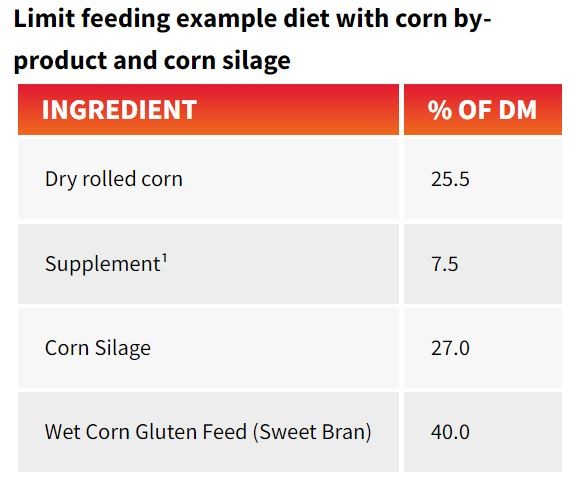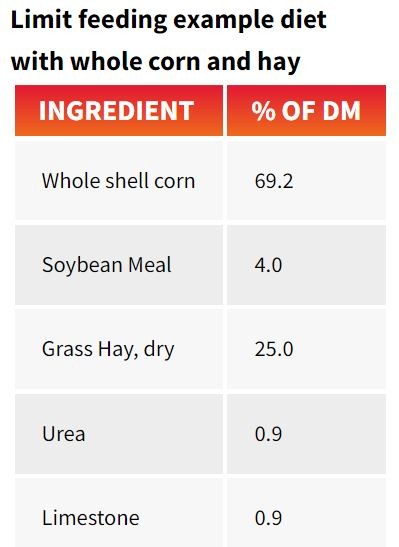Limit Feeding Beef Cattle, by Charlie Sasscer
Limit feeding is the practice of feeding cattle less dry matter (DM) than they would naturally consume on their own if given ad libitum (unlimited) access to a forage diet (hay, silage, etc.). Limit feeding can result in improvements in feed efficiency, or feed: gain (F:G), as well as result in less manure production. Both of these factors can help to decrease the cost of gain (COG) for growing calves, or the cost to the producer to grow one pound of live animal weight. Such management is especially useful this year, as grain prices are much higher than years past. Limit feeding slows the rate of passage in the gut of the animal, allowing the ruminal microbes to better digest feedstuffs.
New research in limit feeding over the past decade has favored utilizing corn by-product feeds, such as wet and dry corn distiller's grains and wet corn gluten feed (SweetBran), due to their high levels of fermentable fibers. This fermentable fiber provides energy to the animals, with a much lower risk of inducing ruminal acidosis than using grain sources that contain high levels of starch. But corn by-product feeds are not as readily available on much of the east coast as they are in the Mid-west and Great Plains regions. Thus, good management is needed for successful limit feeding with feed sources high in starch, such as corn.
If limit feeding is to be implemented, it is highly recommended to utilize a diet calculator. One of the easiest, user-friendly diet calculators can be found at https://extension.okstate.edu/programs/cowculator.html.
 ¹Supplement pellet was formulated to contain (DM basis) 11.09% crude protein, 8.50% calcium, 0.42% phosphorus, 5.50% salt, 0.80% potassium, 0.57% magnesium, 1.70% fat, 11.04% acid detergent fiber, and 331 mg/kg lasalocid.
¹Supplement pellet was formulated to contain (DM basis) 11.09% crude protein, 8.50% calcium, 0.42% phosphorus, 5.50% salt, 0.80% potassium, 0.57% magnesium, 1.70% fat, 11.04% acid detergent fiber, and 331 mg/kg lasalocid.Utilizing a diet formulation software isn't a 100% accurate representation of what will go into your feed bunk, but it is a good place to start to ensure your cattle are receiving the basic requirements of their nutritional needs, such as protein, fiber, calcium, and phosphorus. While some limit-fed diets utilizing corn by-products may have as low as 13% forage on a DM basis, it is a good recommendation to include at a minimum a forage source at 25% of the diet dry matter to deter acidosis. Corn silage or baleage is a great source of roughage when growing cattle, but good management must be utilized to preserve silage quality and/or utilize a full bale of baleage before it spoils. From there, protein requirements must be met with a source such as soybean meal (SBM), or because we're feeding a starch-heavy diet, urea can be utilized at no more than 1% of the diet. A final consideration is to utilize limestone to balance your Calcium: Phosphorus ratio, as cereal grains are high in phosphorus and limestone is a concentrated source of calcium.

A Ca:P ratio of 1.5:1 is optimal, with a range of 1:1 to 4:1 being satisfactory. While cracked corn is the easiest form of corn for cattle to digest, shell corn can be fed to young cattle without compromising performance, as young cattle are able to masticate (or chew) whole corn kernels to break them open and expose the inner starch for ruminal microbes. It is always important to slowly adapt cattle to a new diet and diet ingredients, especially with diets high in starch and utilizing urea. The allocated amount of forage intake, if not more, should be provided initially, and over the course of several weeks, the amount of forage should be decreased as the amounts of corn and urea are brought up to desired levels in the diet.
Many management considerations must be accounted for when limit feeding. Beginning cattle weights are needed to calculate how much feed to give to the cattle, with a goal of 2-2.2% per lbs of body weight on a DM basis. Calves should be weighed at least every other week to readjust the diet and ensure that adequate DM is being provided. In order to provide the proper amount of feed, a scale or mixer wagon with scales is needed to measure out ingredients. Options can be as basic as a manual hanging scale, more advanced such as an electronic platform scale, or more luxurious options such as a mixer wagon. Strong facilities are also needed, as hungry cattle will try to push out of feed bunks and find ways out of fences in search of food. For successful limit feeding, the provided diet needs to be the only diet, meaning cattle need to be kept in dirt lots so they are not consuming forages out in a grass run. Adequate bunk space is also required for all animals to eat at the same time, as the diet will usually be consumed within 4 hours. This can be up to 24" of bunk space per head. Despite these strict guidelines for the implementation of limit feeding, great cattle performance can result. From a health management standpoint, limit feeding makes it easier to observe sick cattle, as the animals should be hungry and eager to eat at feeding times. Any animals with a poor appetite should be evaluated for sickness. As mentioned before, feed efficiency is greatly increased with limit feeding, as much as 20-40+%. With less DMI intake, less manure is produced, as much as 43% less. This can lead to significantly less equipment usage for cleaning pens and spreading manure. If a producer is interested in implementing limit feeding, a good understanding of nutritional and facility management is needed. Private consultants or university extension services can provide this knowledge, and help guide a producer through the successful implementation of a limit feeding program.
This article appears in August 2021, Edition 2, Cattles Tales Livestock Newsletter
Upcoming Events
WEBINAR - Automated Milking Systems Efficiency: Balancing Focus on Individual Cows and System Optimization
May 8, 2024
Please join Cornell the SWNY team and MSU Extension for our talk with Dr. Pablo Silva Boloña on improving efficiency of Automated milking systems by focusing on milking settings for individual and group success.
Broiler Field Day at Sunny Cove Farm
June 6, 2024
Alfred Station, NY
Join us for a field day to explore broiler production, processing, and finances. Meghan Snyder of Sunny Cove Farm will be our host. She raises small batches of organic broilers, processing them on-farm under the 1,000 bird exemption.
Stockmanship and Stewardship 2024
October 25, 2024
Hamburg, NY
Save the date!! The event is one of 4 across the US and is a two-day educational experience featuring low-stress cattle handling demonstrations, Beef Quality Assurance educational sessions, facility design sessions, and industry updates.
Announcements
No announcements at this time.





